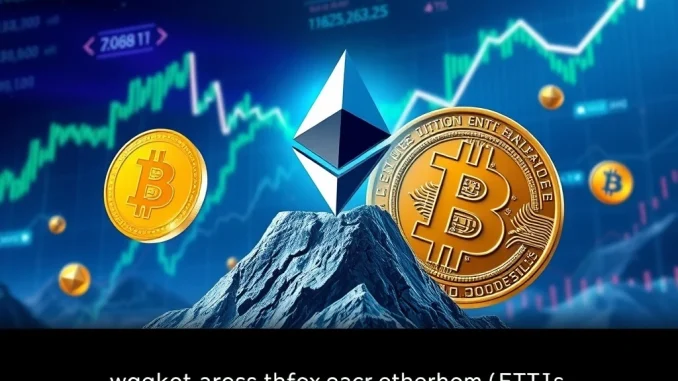
The cryptocurrency market is buzzing, and for good reason! We’re witnessing a pivotal moment for Ethereum as its spot Exchange-Traded Funds (ETFs) achieve an astonishing milestone. Imagine a continuous flow of capital, day after day, for nearly two weeks straight. That’s precisely what’s happening with Ethereum ETFs, signaling a profound shift in institutional investment strategies and potentially reshaping the future of digital assets. Are you ready to dive into the numbers and understand the seismic shifts occurring in the world of crypto finance?
The Unprecedented Surge in Spot Ethereum ETFs: A Deep Dive into the Numbers
In a development that has captivated analysts and investors alike, Spot Ethereum ETFs have recorded an astounding $533.87 million in net inflows on a single day. This monumental influx isn’t a one-off event; it marks an incredible 13-day consecutive streak of positive inflows, pushing the total assets under management (AUM) for these products to an impressive $19.85 billion. To put this into perspective, these ETFs now command a significant 4.44% share of Ethereum’s total market capitalization.
Leading the charge in this financial revolution is BlackRock’s iShares Ethereum Trust (ETHA), which single-handedly captured a colossal $426.22 million in daily inflows. Not far behind, Fidelity’s FETH also contributed significantly, adding $35 million to the growing pool. Since their inception on July 2, cumulative inflows into these groundbreaking financial products have soared past $8.32 billion. This isn’t just about big numbers; it’s a clear indicator of burgeoning institutional confidence in Ethereum, occurring at a time when Bitcoin’s market dominance appears to be subtly declining. This sustained trend reflects a deliberate and strategic rebalancing within institutional crypto portfolios, highlighting Ethereum’s increasing allure.
Why Institutional Investors Are Pouring into ETH ETFs: Beyond Speculation
So, what’s driving this relentless march of capital into ETH inflows? Analysts point to a confluence of factors that extend far beyond mere speculative trading. The primary driver appears to be Ethereum’s expanding utility, particularly its foundational role in decentralized finance (DeFi), NFTs, and various Web3 applications. Unlike Bitcoin, which is primarily seen as digital gold, Ethereum offers a robust ecosystem for innovation, making it an attractive long-term investment for institutions seeking growth opportunities within the digital economy.
Vincent Liu of Kronos Research eloquently articulated this sentiment, emphasizing that the 13-day streak signifies "institutional conviction rather than speculative trading." This conviction suggests that major players are not just chasing short-term gains but are making strategic bets on Ethereum’s long-term potential and its evolving ecosystem. Liu further noted that Ethereum’s market share gains could potentially outpace Bitcoin’s in the coming months, indicating a potential paradigm shift in the crypto landscape.
Matt Hougan of Bitwise highlighted a crucial disparity: despite Ethereum’s market capitalization being approximately 19% of Bitcoin’s, its ETF assets currently stand at only 12% of Bitcoin ETFs. This gap, Hougan suggests, represents a significant opportunity. He projected that Ethereum ETFs, coupled with direct corporate ETH holdings, could generate demand for roughly 5.33 million ETH (equivalent to about $20 billion at current prices) over the next year. This projected demand vastly overshadows Ethereum’s anticipated supply of just 0.8 million ETH during the same period, setting the stage for potentially explosive price action.
Decoding the Capital Rotation: Ethereum’s Ascent Amidst Bitcoin’s Shifts
The remarkable ETH inflows into Ethereum ETFs have coincided with broader market dynamics that reveal a fascinating capital rotation. For instance, while Ethereum ETFs were basking in their glory, spot Bitcoin ETFs registered $67.93 million in net outflows on July 23. Leading these withdrawals were Bitwise’s BITB and Ark’s ARKB, with $42.27 million and $33.18 million in outflows, respectively.
This simultaneous occurrence of significant inflows into Ethereum ETFs and outflows from Bitcoin ETFs is not indicative of a sector-wide weakness. Instead, it strongly suggests an institutional rebalancing act. Large investors are strategically reallocating capital, diversifying their crypto holdings, and perhaps increasing their exposure to Ethereum as its utility and adoption grow. This rebalancing act underscores the evolving maturity of the crypto market, where institutional players are becoming more sophisticated in their portfolio management.
Beyond the ETF landscape, data from Lookonchain further corroborates this accumulation trend, revealing that 76,987 ETH (approximately $285 million) was withdrawn from Kraken. Such withdrawals from exchanges often indicate that investors are moving their assets into cold storage or self-custody, signaling a long-term holding strategy rather than short-term trading intentions. This off-exchange movement complements the ETF inflows, painting a comprehensive picture of robust demand for Ethereum.
What This Means for Ethereum’s Price Trajectory: Demand Outpacing Supply
The implications of these sustained inflows for Ethereum price trajectory are profoundly significant. With Matt Hougan’s projection of demand potentially outpacing supply by a staggering sevenfold (5.33 million ETH demand vs. 0.8 million ETH supply), the stage is set for considerable upward price pressure. Such a supply-demand imbalance, especially when fueled by institutional conviction, historically leads to substantial price appreciation.
Hougan’s argument that institutions are currently "underweighting" Ethereum compared to Bitcoin presents a compelling correction opportunity. As more institutions recognize Ethereum’s foundational role in the digital economy and its potential for growth, they are likely to increase their allocations, further driving demand. Vincent Liu added that macroeconomic stability will play a crucial role in sustaining this inflow trend, suggesting that a favorable global economic environment could continue to fuel institutional appetite for risk assets like Ethereum.
Since July 2, Ethereum ETFs have collectively accumulated over $4 billion in net inflows, firmly positioning Ethereum as a complementary pillar in diversified crypto portfolios. This trend highlights Ethereum’s maturation as an asset class, moving beyond niche speculation to become a legitimate component of sophisticated investment strategies.
The Future of Institutional Crypto Investment: Beyond ETFs
As the market continues to evolve, Ethereum’s ETF momentum aligns seamlessly with broader trends in tokenization and DeFi adoption. Major asset managers are no longer just observing; they are actively experimenting with tokenized government securities on public blockchains, enhancing liquidity and settlement efficiency. These groundbreaking developments hint at a future where traditional financial assets are seamlessly integrated with blockchain technology, with Ethereum often serving as the preferred infrastructure.
These initiatives suggest that Ethereum’s institutional adoption could very well mirror Bitcoin’s trajectory, albeit with distinct advantages related to its programmable nature and diverse use cases. While Bitcoin serves as a store of value, Ethereum offers a platform for innovation, making it attractive for a wider range of applications and institutional endeavors. The sustained interest from institutional crypto investors is a testament to Ethereum’s growing importance in the global financial landscape.
The convergence of increasing ETF inflows, strategic institutional rebalancing, and the ongoing development of blockchain applications positions Ethereum at the forefront of the next wave of digital asset adoption. The journey of Ethereum from a nascent technology to an institutional-grade asset is a testament to its enduring utility and the unwavering conviction of its proponents.
Conclusion: Ethereum’s Ascendant Trajectory
The recent surge in Spot Ethereum ETF inflows, culminating in a remarkable 13-day streak and pushing AUM to nearly $20 billion, is more than just a headline; it’s a powerful affirmation of Ethereum’s growing stature in the global financial ecosystem. This sustained institutional conviction, evidenced by major players like BlackRock and Fidelity, underscores Ethereum’s expanding utility and its strategic role in diversified crypto portfolios. As demand continues to outpace supply, and as the lines between traditional finance and blockchain blur, Ethereum is not just holding its own; it’s carving out a dominant position, promising an exciting future for investors and innovators alike. This is truly a pivotal moment, signaling a new era for digital asset investment.
Frequently Asked Questions (FAQs)
1. What are Spot Ethereum ETFs?
Spot Ethereum ETFs (Exchange-Traded Funds) are investment vehicles that hold actual Ether (ETH), the native cryptocurrency of the Ethereum blockchain. They allow traditional investors to gain exposure to the price movements of Ethereum without directly owning or managing the cryptocurrency themselves, offering a regulated and accessible pathway for investment.
2. Why are Ethereum ETFs seeing such high inflows?
The high inflows into Ethereum ETFs are primarily driven by growing institutional conviction, Ethereum’s expanding utility (especially in DeFi and Web3), and favorable macroeconomic conditions. Institutions are increasingly diversifying their crypto portfolios, viewing Ethereum as a strategic long-term investment due to its robust ecosystem and potential for innovation.
3. How do Ethereum ETF inflows impact ETH price?
Significant and sustained inflows into Ethereum ETFs create strong buying pressure for ETH. When demand from these large institutional funds outstrips the available supply of new Ether, it can lead to upward price movements. Analysts project that current demand from ETFs could far exceed Ethereum’s projected supply, potentially leading to substantial price appreciation.
4. What is the difference between Bitcoin and Ethereum ETF trends currently?
While both Bitcoin and Ethereum ETFs attract institutional capital, recent trends show a notable capital rotation. On days when Ethereum ETFs experience massive inflows, Bitcoin ETFs have sometimes seen net outflows. This suggests that institutions are rebalancing their portfolios, potentially increasing their allocation to Ethereum while adjusting their Bitcoin exposure, rather than indicating a sector-wide downturn.
5. Is Ethereum becoming an institutional-grade asset?
Yes, the consistent and substantial inflows into Ethereum ETFs, coupled with major asset managers’ interest in leveraging the Ethereum blockchain for tokenized assets, strongly indicate that Ethereum is rapidly maturing into an institutional-grade asset. Its foundational role in DeFi and its programmable capabilities make it an attractive and essential component for diversified institutional crypto portfolios.



